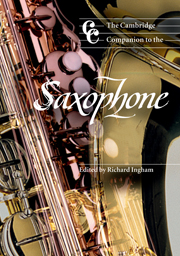Book contents
- Frontmatter
- 1 Invention and development
- 2 In the twentieth century
- 3 Influential soloists
- 4 The repertoire heritage
- 5 The saxophone quartet
- 6 The mechanics of playing the saxophone: Saxophone technique
- 7 The professional player: The saxophone in the orchestra
- 8 Jazz and the saxophone
- 9 Rock and the saxophone
- 10 The saxophone today: The contemporary saxophone
- 11 Teaching the saxophone
- Notes
- Appendices
- Bibliography
- Index
9 - Rock and the saxophone
Published online by Cambridge University Press: 28 September 2011
- Frontmatter
- 1 Invention and development
- 2 In the twentieth century
- 3 Influential soloists
- 4 The repertoire heritage
- 5 The saxophone quartet
- 6 The mechanics of playing the saxophone: Saxophone technique
- 7 The professional player: The saxophone in the orchestra
- 8 Jazz and the saxophone
- 9 Rock and the saxophone
- 10 The saxophone today: The contemporary saxophone
- 11 Teaching the saxophone
- Notes
- Appendices
- Bibliography
- Index
Summary
In the vocally dominated genres of rock and pop, the saxophone has made its own special contribution, using its unique vocal attributes with conflicting personalities of sweetness and anguish. From the jump style of Louis Jordan to Courtney Pine's hip-hop, and from Junior Walker through the Baker Street phenomenon to Branford Marsalis and Kenny Gee, saxophone soloists and sections have played a crucial role. But is it rock or pop, is it rock and roll, rhythm and blues, soul, dance or funk? The transient nature of much popular music makes historical accounts sometimes vague, often conjecture, and always selective, but this short chapter will attempt to identify the general trends and most significant exponents.
The big bands of the 1930s and 1940s featured and relied on major soloists, and an important precursor of rock saxophone was to be found in the ‘Texas’ tenor sound of Arnett Cobb, Illinois Jacquet, Buddy Tate and the alto of Eddie Vinson. Stars of the Lionel Hampton and Count Basie bands in the main, their playing was renowned for its excitement and energy and was steeped in the blues. Cries and wails coloured their solos as well as riff developments; a trademark was the use of the extended upper register. Illinois Jacquet's solos with the Hampton band in Flying Home (original 1942) became legendary. ‘Cleanhead’ Vinson concentrated his career on blues playing and singing, although he was also a fine bop player, and employed the young John Coltrane in his band in 1948.
- Type
- Chapter
- Information
- The Cambridge Companion to the Saxophone , pp. 153 - 160Publisher: Cambridge University PressPrint publication year: 1999

